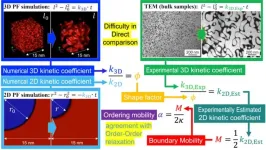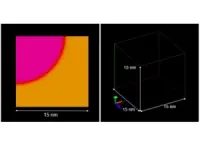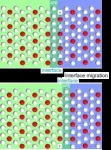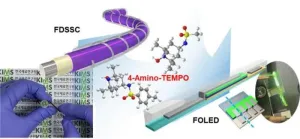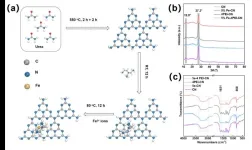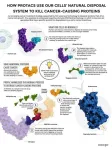(Press-News.org) Osaka, Japan – The compound of iron and aluminum with the chemical formula Fe3Al has some very useful mechanical properties. A team from Osaka University has combined simulations with experimental techniques to better understand the kinetics of the formation of microstructures to enhance and utilize these properties and how to harness them for specific applications.
In a study recently published in Acta Materialia, the researchers took an in-depth look at the way the microstructure of Fe3Al develops because the ordered domains that form contribute to one of its key properties: superelasticity.
When high loads are applied to superelastic materials they can deform to large strains which would result in a permanent strain in conventional materials without break. Interestingly, they can return to their original shape when unload. This can be used in a diverse range of applications from healthcare materials seismic devices for construction materials.
Superelasticity results from the way the atoms are arranged in a material. This can differ between materials. In the most well-known superelastic material, i.e. TiNi alloys,which consist of precious and rare metals of titanium and nickel, the change of crystal structures in response to the load (i.e. Martensitic transformation) is responsible for the large plastic deformation and the recovery of the shape. In contrast, In Fe3Al consisting of common metals of iron and aluminum, the superelastic properties are caused not by the change of crystal structure but by dislocation slip, which is the relative displacement of atoms keeping crystal structure. Dislocation slip normally gives rise to permanent strain. However, when there is a force which can gives rise to the back motion of dislocation. In Fe3Al, the back motion of dislocation can be caused by antiphase boundaries (APB) which separates areas within a material known as domains, and the shape and size of the boundaries between these domains contribute to the superelastic properties.
“To harness particular material properties and ensure they are appropriate for their application, you have to understand what is happening,” explains study lead author Yuheng Liu. “Until now, ordering mobility studies of the atoms in Fe3Al have led to different interpretations depending on the experimental technique. We have therefore combined phase-field computer simulations and transmission electron microscopy (TEM) experiments to finally get a good picture.”
The computer simulations predicted the 3D shapes of the areas in the Fe3Al with ordered structure. These findings were then compared with TEM observations for Fe3Al samples heated to different temperatures. The combined data revealed the mobility for forming the ordered D03-type structure.
The D03 structure of Fe3Al is similar to L21 structure of other materials. The findings could therefore provide a starting point for exploring heat treatments for other functional materials, including half metals for spintronics, which may become crucial for quantum computing in the near future.
“It is challenging to design experiments that can capture the movement of boundaries and the details of how the microstructure evolves, particularly in the early stages of ordering,” says senior author Yuichiro Koizumi. “The phase-field simulations provide a window into the process that has been missing from previous studies.”
The study findings are expected to support applications in the construction industry. For example, Fe3Al could be used to 3D print structural parts that can act as shock absorbers for seismic activity.
###
The study, “Resolving the long-standing discrepancy in Fe3Al ordering mobilities: A synergistic experimental and phase-field study,” was published in Acta Materialia at DOI: https://doi.org/10.1016/j.actamat.2024.119958.
About Osaka University
Osaka University was founded in 1931 as one of the seven imperial universities of Japan and is now one of Japan's leading comprehensive universities with a broad disciplinary spectrum. This strength is coupled with a singular drive for innovation that extends throughout the scientific process, from fundamental research to the creation of applied technology with positive economic impacts. Its commitment to innovation has been recognized in Japan and around the world. Now, Osaka University is leveraging its role as a Designated National University Corporation selected by the Ministry of Education, Culture, Sports, Science and Technology to contribute to innovation for human welfare, sustainable development of society, and social transformation.
Website: https://resou.osaka-u.ac.jp/en
END
Combining simulations and experiments to get the best out of Fe3Al
Researchers from Osaka University have used electron microscopy and computer simulations to get a thorough understanding of an iron and aluminum alloy
2024-05-30
ELSE PRESS RELEASES FROM THIS DATE:
Both high performance and stability were achieved with multifunctional materials!
2024-05-30
Through joint research with Professor Chul-jin Ahn’s team at Changwon National University, the research team of Dr. Jae-Ho Kim and Dr. Myung-kwan Song from the Department of Energy & Electronic Materials in the Surface & Nano Materials Division has developed a 4-Amino-TEMPO derivative with photocatalytic properties and successfully used it to produce high-performance and stable fiber-shaped dye-sensitized solar cells (FDSSCs) and fiber-shaped organic light-emitting diodes (FOLEDs). The developed 4-Amino-TEMPO derivative has the characteristic of simultaneously improving the performance of both fiber-shaped dye-sensitized solar cells (FDSSCs) and fiber-shaped ...
Structural inequities amplify homelessness challenges for pregnant people in Washington DC
2024-05-30
WASHINGTON -- New research conducted with Washington, DC, residents who experienced homelessness during pregnancy sheds light on the intersection of homelessness, pregnancy, and racial inequities. The findings underscore the urgent need for policy and practice changes to support vulnerable populations.
The study, published May 30, 2024 in the journal Health Equity (DOI: 10.1089/heq.2023.0235), is grounded in a reproductive justice framework and delves into the lived experiences of 20 DC residents who faced homelessness while pregnant.
Homelessness ...
University of Maryland study shows N95 masks near-perfect at blocking escape of airborne COVID-19
2024-05-30
COLLEGE PARK, Md. – In a head-to-head comparison of masks worn by people with active
COVID-19, the inexpensive “duckbill” N95 came out on top, stopping 98% of COVID-19 particles
in the breath of infected people from escaping into the air. Led by researchers from the University
of Maryland School of Public Health (SPH), results showed other masks also performed well,
blocking at least 70% of viral particles from escaping from the source – an infected person’s
exhaled breath.
The study, Relative efficacy of masks and respirators as source control for viral aerosol shedding
from people infected with SARS-CoV-2, published May 29 in eBioMedicine, a Lancet ...
The AI paradox: Building creativity to protect against AI
2024-05-30
Cultivating creativity in schools is vital for a future driven by artificial intelligence (AI). But while teachers embrace creativity as an essential 21st century skill, a lack of valid and reliable creativity tests means schools struggle to assess student achievement.
Now, a new machine-learning model developed by the University of South Australia is providing teachers with access to high-quality, fit-for-purpose creativity tests, that can score assessments in a fraction of the time and a fraction of the cost.
Applied to the current ...
Visible light-induced photocatalysis–self-Fenton degradation of P-Clphoh over graphitic carbon nitride by a polyethylenimine bifunctional catalyst
2024-05-30
The deep degradation of organic pollutants through solar light-coupled photocatalysis and the Fenton reaction (Photo-Fenton) holds significant importance in the field of water purification. In this study, a novel bifunctional catalyst (Fe-PEI-CN) was synthesized by electrostatic self-assembly and hydrothermal methods, doping graphene-like carbon nitride (CN) with polyethyleneimine (PEI) and iron (Fe) species. This catalyst efficiently degraded p-chlorophenol (p-ClPhOH) by generating hydrogen peroxide (H2O2) during the photocatalytic process. The relationship between catalytic efficiency and structure was explored using various characterization techniques.Under ...
Engineered DNA 'warhead' targets a common cancer mutation
2024-05-30
Tumour protein P53 (TP53) plays an important role in suppressing the growth of tumours. Mutations in the gene for TP53 can have a disastrous effect, hampering the body's ability to fight tumours and even encouraging their growth. Because these are the most common mutations in cancers, TP53 has long been an interesting therapeutic target. However, efforts to destroy the mutant protein have been hampered by the difficulty of finding a way to bind to it.
Now, a team of researchers from Xi'an ...
Picture this: Snapping photos of our food could be good for us
2024-05-30
New Curtin University research reveals taking pictures of food isn’t just content for our social media feeds, but could be the key to improving people’s diets.
Published in the prestigious American Journal of Clinical Nutrition, the feeding study saw researchers measure the weight of meals, which were then provided to participants over a day for breakfast, lunch and dinner.
Participants compared different technology-assisted methods to recall what they had eaten over the past 24 hours.
One method asked participants to take photos of their meals using the mobile Food Record app.
These ...
Portable pathology passes the test
2024-05-30
On-site pathology tests for infectious diseases in rural and remote locations can be just as reliable and accurate as tests carried out in a hospital laboratory, a new report from Flinders University shows.
Flinders University researchers tested the quality of on-site pathology testing, or Point-of-Care-Testing (POCT), for molecular-based, severe acute respiratory syndrome coronavirus 2 (SARS-CoV-2) detection in over 100 remote Aboriginal and Torres Strait Islander communities across Australia.
“Our study demonstrates that when point-of-care testing models are effectively established and managed, the quality of pathology results can be equivalent to ...
USC medical school dean appointed to CIRM board
2024-05-30
Carolyn C. Meltzer, MD, dean of the Keck School of Medicine of USC, has been appointed to the board overseeing the California Institute of Regenerative Medicine (CIRM). CIRM is the voter-created agency that funds stem cell research throughout the state.
“Stem cell research holds the tremendous promise to unlock health solutions that patients need,” said Steven D. Shapiro, MD, USC’s senior vice president for health affairs. “The CIRM board—and the people of our state—will benefit greatly from Meltzer’s wide-ranging leadership experience and place at the ...
Antibiotic pollution disrupts the gut microbiome and blocks memory in aquatic snails
2024-05-30
Antibiotics prevent snails from forming new memories by disrupting their gut microbiome - the community of beneficial bacteria found in their guts.
The new research, led by the University of East Anglia (UEA) in collaboration with Aberystwyth University, highlights the damaging effects that human pollution could be having on aquatic wildlife.
In the study, pond snails were given a favourite food – carrot juice – but had to quickly learn and remember that it was no longer safe to eat.
Snails ...
LAST 30 PRESS RELEASES:
Exposure to wildfire smoke late in pregnancy may raise autism risk in children
Breaking barriers in lymphatic imaging: Rice’s SynthX Center leads up to $18 million effort for ‘unprecedented resolution and safety’
Dhaval Jadav joins the SETI Institute Board to help spearhead novel science and technology approaches in the search for extraterrestrial life
Political writing retains an important and complex role in the national conversation, new book shows
Weill Cornell Medicine receives funding to develop diagnostic toolbox for lymphatic disease
It started with a cat: How 100 years of quantum weirdness powers today’s tech
McGill researchers identify a range of unexpected chemical contaminants in human milk
Physical therapy research highlights arthritis’ toll on the workforce — and the path forward
Biomedical and life science articles by female researchers spend longer under review
Forgetting in infants can be prevented in mice by blocking their brain’s immune cells
Blocking immune cells in the brain can prevent infant forgetting
AI-driven ultrafast spectrometer-on-a-chip: A revolution in real-time sensing
World enters “era of global water bankruptcy”; UN scientists formally define new post-crisis reality for billions
Innovations in spatial imaging could unlock higher wheat yields
A twitch in time? Quantum collapse models hint at tiny time fluctuations
Community water fluoridation not linked to lower birth weight, large US study finds
Stanford University’s Guosong Hong announced as inaugural recipient of the SPIE Biophotonics Discovery’s Impact of the Year Award
Ice, ice, maybe: There’s always a thin layer of water on ice — or is there?
Machine learning lends a helping ‘hand’ to prosthetics
Noninvasive brain scanning could send signals to paralyzed limbs
Community water fluoridation and birth outcomes
SGLT2 inhibitors vs GLP-1 receptor agonists for kidney outcomes in individuals with type 2 diabetes
Long-term exposure to air pollution and risk and prognosis of motor neuron disease
Five-year absolute risk–based and age-based breast cancer screening in the US
Study finds elevated alcohol involvement in suicides of lesbian, gay and bisexual women
Air pollution may increase the risk of the neurodegenerative disease ALS
Chronic kidney disease poisons patients’ hearts, scientists discover
Hollings researchers reveal why some pancreatic tumors behave differently
DNA ties gut motility to vitamin B1
Study suggests pathway for life-sustaining conditions in Europa’s ocean
[Press-News.org] Combining simulations and experiments to get the best out of Fe3AlResearchers from Osaka University have used electron microscopy and computer simulations to get a thorough understanding of an iron and aluminum alloy
